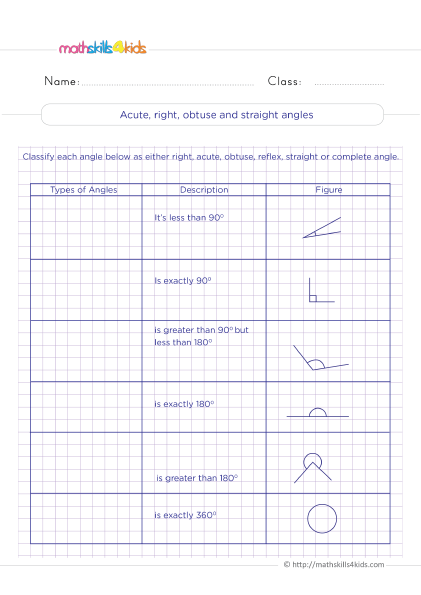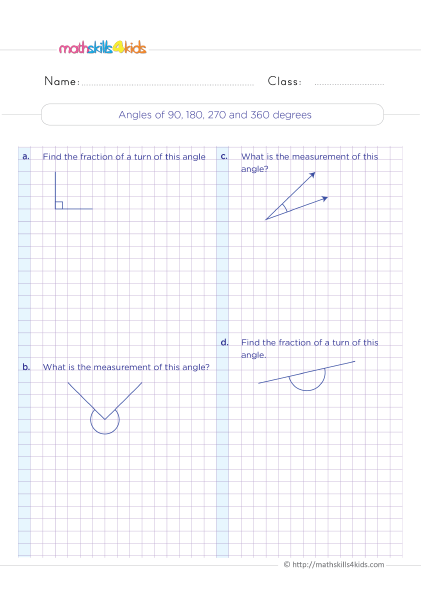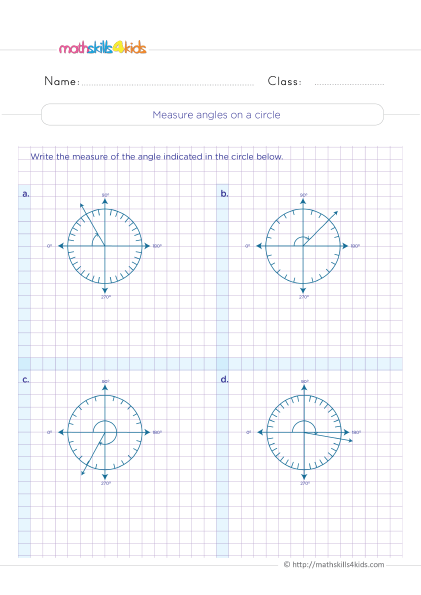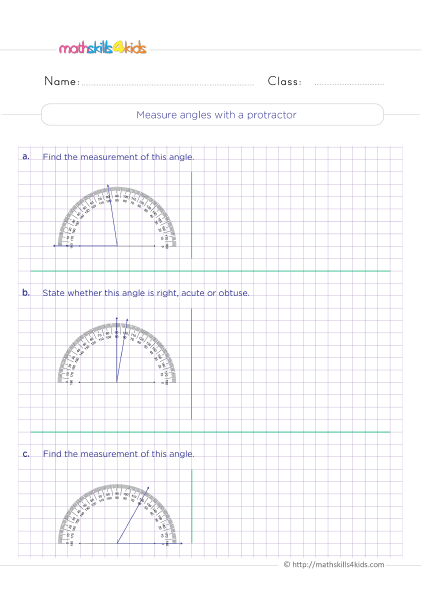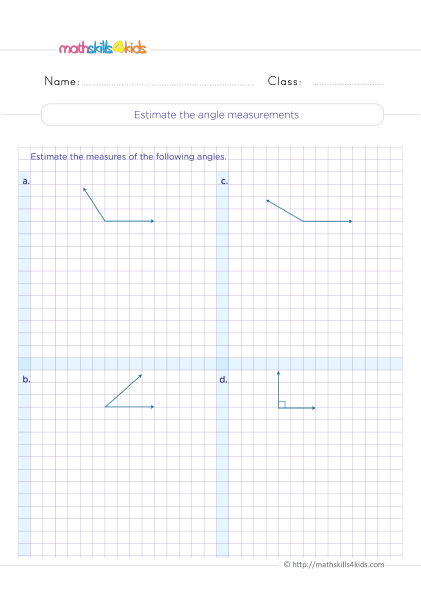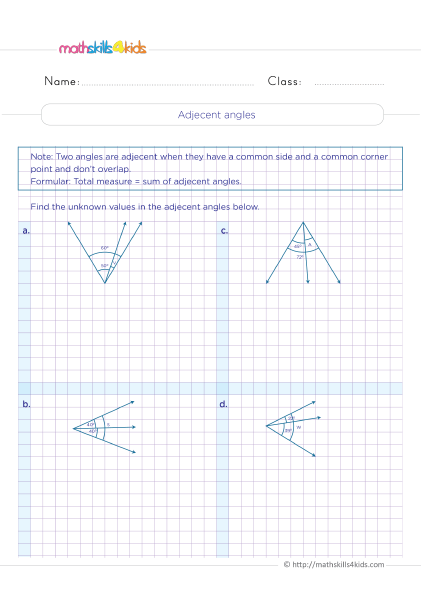4th Grade math worksheets Pdf: Identifying & Measuring Angles
-
Hello everyone! Welcome to another brilliant Grade 4 math article about identifying & measuring angles. You will enjoy this perfect balance of teaching and learning angles with our Mathskills4kids.com 4th Grade math worksheets Pdf designed with various fun, engaging exercises and visually appealing illustrations.
Let’s dive in and see how to use these worksheets!
Boosting math skills: Printable worksheets for identifying and measuring angles in 4th Grade
Are you a 4th-grade teacher or a parent looking to boost your child's math skills? Look no further! Our printable worksheets on identifying and measuring angles are designed to help 4th graders master this important mathematical concept.
Whether understanding the difference between acute, obtuse, and right angles or measuring angles using a protractor, our 4th Grade math worksheets cover all the essential skills needed to excel in geometry.
Not only will these worksheets reinforce classroom learning, but they are also a great resource for homeschooling or extra practice at home. So, why wait? Start boosting your child's math skills today with our printable worksheets on identifying and measuring angles for 4th graders!
-
BROWSE THE WEBSITE
-
DOWNLOAD FREE WORKSHEETS
-
-
4th GRADE MATH TOPICS
- Number sense
- Addition
- Subtraction
- Multiplication
- Division
- Mixed operations
- Variable expressions
- Functions
- Coordinate plane
- Data and graphs
- Logical reasoning
- Patterns and sequences
- Money math
- Units measurement
- Telling time
- Equivalent fractions
- Compare & order fractions
- Add & subtract fractions with like denominators
- Add & subtract fractions with unlike denominators
- Multiply fractions
- Decimals
- Add and subtract decimals
- Probabilities and statistics
- 2D shapes
- Triangles and quadrilaterals
- Symmetry
- Angles
- 3D shapes
- Geometric measurement
-
Buying is supporting us!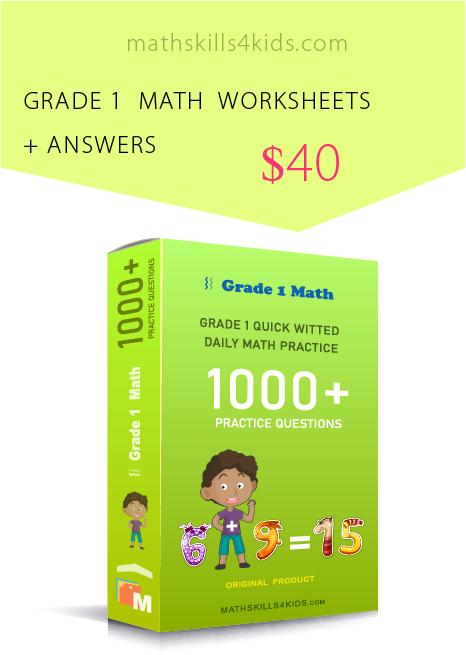
Buy Now...
-
-
Printable worksheets for identifying angles in 4th grade
Mathematics can be challenging for many students, especially when understanding geometric concepts such as angles. However, learning about angles can be both enjoyable and rewarding with the right resources and approach. Our printable worksheets for identifying angles in 4th grade are designed to give students the necessary practice and reinforcement to develop a strong foundation in geometry.
These worksheets cover various topics, including identifying different types of angles, measuring angles using a protractor, and understanding the relationship between angles and shapes. Each worksheet is carefully crafted to ensure students have ample opportunities to apply their knowledge and develop problem-solving skills.
With clear instructions and visually appealing illustrations, these worksheets make learning about angles a fun and engaging experience.
-
Understanding angles and their relevance in math education
Angles learning is greatly relevant in math education and is crucial in various disciplines, including geometry, trigonometry, and physics. Understanding angles is also essential as it provides a basis for analyzing shapes, measuring distances, and solving real-life problems. In the 4th grade, students explore angles and their properties, building a solid foundation for more advanced mathematical concepts.
We help students develop critical thinking skills and spatial awareness by introducing angles to them at an early age. This knowledge will serve them well as they progress through their academic journey and encounter more complex mathematical concepts.
Also, understanding angles can have practical applications in everyday life, such as reading maps, designing structures, or even playing sports.
-
Types of angles
Before diving into the world of angles, it's important to familiarize oneself with the different types of angles. In geometry, angles can be classified into several categories based on their measurements and relationships with other angles. Here are some of the most common types of angles that students encounter in the 4th grade:
- Acute angles: These angles measure less than 90 degrees and are often seen in everyday objects, such as square or triangle corners. Acute angles are known for their sharpness and can be found in various geometric shapes.
- Obtuse angles: Unlike acute angles, obtuse angles measure more than 90 degrees but less than 180 degrees. They are wider and less sharp than acute angles and can be seen in shapes like rectangles or parallelograms.
- Right angles: A right angle measures exactly 90 degrees and is often represented as a small square. Right angles are commonly found in objects with perpendicular sides, such as the corners of a book or the table's edge.
- Straight angles: A straight angle measures 180 degrees and forms a straight line. It can be visualized as a line segment extending from one point to another without bends or curves.
- Reflex angles: Reflex angles measure more than 180 degrees but less than 360 degrees. They are often seen in shapes with concave sides, such as an irregular polygon or a crescent.
Understanding the different types of angles is crucial as it allows students to identify and categorize angles based on their measurements, enabling them to solve angle-related problems more effectively.
-
The benefits of hands-on learning in angles lessons
Regarding teaching angles, incorporating hands-on learning activities can significantly enhance students' understanding and retention of the concepts. Traditional teaching methods often rely on rote memorization and passive learning, which can lead to disengagement and limited comprehension. Some benefits of hands-on learning in angles lessons include:
- Incorporating hands-on activities can help educators to create a dynamic learning environment that promotes active participation and critical thinking.
- Hands-on learning allows students to explore angles through tactile experiences and real-world applications.
- By manipulating physical objects, measuring angles using tools like protractors, and engaging in collaborative problem-solving, students can develop a deeper understanding of angles and their properties.
- This interactive approach makes learning more enjoyable and facilitates long-term retention of the concepts.
- Research has shown that hands-on learning activities can improve students' conceptual understanding, problem-solving skills, and academic performance.
- By actively engaging with the material, students are more likely to develop a deeper understanding of angles and apply their knowledge to real-life situations.
- Hands-on learning also promotes creativity, critical thinking, and teamwork, essential skills for success in the 21st century.
-
Why printable worksheets are beneficial for learning angles
Printable worksheets are valuable for teaching and reinforcing angles concepts in the 4th grade. Here are some reasons why printable worksheets are beneficial for learning angles:
- Accessibility and convenience: Printable worksheets can be easily accessed and printed from the comfort of your home or classroom. They provide a flexible and convenient learning tool that can be used anytime, anywhere.
- Individualized practice: Printable worksheets allow students to work at their own pace and provide opportunities for individualized practice. Students can revisit challenging concepts and focus on areas that require additional reinforcement.
- Engaging visuals: Printable worksheets often include visually appealing illustrations and diagrams that help students visualize angles and their properties. These visuals make learning more engaging and facilitate better comprehension.
- Progress tracking: Printable worksheets often come with answer keys, allowing students and educators to track progress and identify improvement areas. This feedback loop is crucial for monitoring student performance and adjusting instruction accordingly.
- Supplemental learning: Printable worksheets can serve as supplementary materials to reinforce classroom learning or provide additional practice at home. They can be used alongside textbooks, online resources, and other instructional materials to enhance students' understanding of angles.
By incorporating printable worksheets into angles lessons, educators can provide students with a versatile and engaging tool that promotes independent learning and reinforces key concepts.
-
Interactive activities for measuring angles in 4th grade
Measuring angles is an essential skill that students need to develop in the 4th grade. It allows them to accurately determine the size of angles and apply their knowledge to solve geometric problems. Here are some interactive activities that can help students practice measuring angles in 4th Grade:
- Angle scavenger hunt: Create a list of common objects or shapes with specific angles. Students can use a protractor to measure the angles and record their findings. This activity encourages students to identify angles in real-life contexts and develop their measuring skills.
- Angle estimation challenge: Show students a series of angles and ask them to estimate the measurement without using a protractor. After estimating, students can use a protractor to measure the angles and compare their estimates with the actual measurements. This activity helps students develop their visual estimation skills and reinforces the concept of angle measurement.
- Angle construction: Give students angle measurements and ask them to construct the angles using a protractor and ruler. This activity promotes spatial reasoning and allows students to apply their angle measurement and construction knowledge.
- Angle puzzles: Create puzzles or riddles that involve angles. Students can solve the puzzles by applying their angle measurement and properties knowledge. This activity encourages critical thinking and problem-solving skills while reinforcing angle concepts.
These interactive activities make learning about angles more enjoyable and provide students with valuable opportunities to practice measuring angles and apply their knowledge in different contexts.
-
Measuring angles on printable worksheets in 4th grade
Printable worksheets provide an excellent platform for students to practice measuring angles independently. Here are some tips for effectively using Mathskills4kids’ printable 4th Grade math worksheets pdf to teach angle measurement in the 4th-grade class:
- Clear instructions: Ensure that the instructions on the worksheets are clear and easy to understand. Students should clearly know what is expected of them and how to use a protractor to measure angles accurately.
- Gradual progression: Start with simple angles and gradually increase the complexity as students become more comfortable with angle measurement. This gradual progression allows students to build confidence and develop their measuring skills step by step.
- Variety of exercises: Include a variety of exercises that cover different types of angles and require students to use a protractor to measure angles in various contexts. This variety helps students better understand angle measurement and its applications.
- Visual cues: Use visually appealing illustrations and diagrams to support students' understanding of angle measurement. Visual cues can help students visualize angles and make accurate measurements.
- Answer keys: Provide answer keys with the worksheets so students can check their work and receive immediate feedback. This feedback is crucial for students to identify and correct any misconceptions.
Educators can create a comprehensive and effective tool for teaching angle measurement in the 4th grade by incorporating these strategies into printable worksheets.
-
Tips for incorporating printable worksheets in teaching angles lessons
To maximize the effectiveness of printable worksheets in teaching angles lessons, here are some tips for educators:
- Align with curriculum: Ensure that the content of the worksheets aligns with the curriculum and learning objectives. This ensures that students practice the skills and concepts required for their grade level.
- Differentiate instruction: Provide various worksheets catering to different learning styles and abilities. Some students may require additional support or extension activities to meet their needs.
- Provide guidance: Offer clear instructions and guidance on how to use the worksheets effectively. This can include demonstrating how to use a protractor, providing examples of completed worksheets, or offering step-by-step instructions for specific exercises.
- Monitor progress: Regularly assess students' progress and understanding by reviewing completed worksheets or administering quizzes. This allows educators to identify areas that need further reinforcement and adjust instruction accordingly.
- Promote independent learning: Encourage students to work independently on the worksheets, fostering self-directed learning and problem-solving skills. However, be available to provide support and guidance when needed.
By implementing these tips, educators can effectively incorporate printable worksheets into their angles lessons, promoting student engagement, independent learning, and mastery of angle concepts.
Bonus: Online resources for additional angles practice and reinforcement for 4th graders
In addition to 4th Grade identifying and measuring angles worksheets, various online resources can provide additional angles practice and reinforcement for 4th graders. Here are some recommended websites:
- [Math Playground](https://www.mathplayground.com/.): Math Playground offers various interactive games and activities covering various math topics, including angles. Students can explore angles through games, puzzles, and virtual manipulatives.
- [Khan Academy](https://www.khanacademy.org/.): Khan Academy provides comprehensive video lessons, practice exercises, and quizzes on various math topics, including angles. Their interactive platform allows students to learn at their own pace and receive personalized feedback.
- [Coolmath4kids](https://www.coolmath4kids.com/.): Coolmath4kids offers engaging math games and activities for elementary school students. They have a dedicated section on angles that provides interactive lessons and practice exercises.
- [BBC Bitesize](https://www.bbc.co.uk/bitesize/topics/zgthvcw.): BBC Bitesize provides educational resources for students of all ages. Their angles section includes interactive lessons, quizzes, and revision materials suitable for 4th graders.
-
-
Thank you for sharing the links of MathSkills4Kids.com with your loved ones. Your choice is greatly appreciated.
Conclusion
In conclusion, our 4th Grade identifying and measuring angles worksheets pdf provides a valuable tool for empowering 4th graders to develop their angle skills.
Educators can create engaging and effective angles lessons by incorporating hands-on learning activities, understanding the different angles, and providing interactive exercises.
Printable worksheets offer a convenient and accessible way for students to practice identifying and measuring angles while reinforcing key concepts. When combined with online resources and well-rounded math education, printable worksheets can play a vital role in boosting 4th graders' math skills and laying a strong foundation for future mathematical success.
So, why wait? Start exploring the world of angles with our 4th Grade math worksheets. Pdf: identifying & measuring angles today and watch your child's math skills soar!
